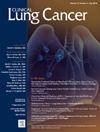液体活检和 18F-FDG PET/CT 导出参数作为奥希替尼治疗晚期表皮生长因子受体突变 NSCLC 的预测因素
IF 3.3
3区 医学
Q2 ONCOLOGY
引用次数: 0
摘要
研究目的尽管奥希替尼治疗晚期表皮生长因子受体(EGFR)突变的NSCLC取得了卓越的疗效,但耐药性的产生几乎是不可避免的。虽然导致奥希替尼耐药的分子机制正在被逐渐揭示,但预测性生物标志物的定义对于识别进展风险较高的患者并优化治疗策略至关重要:这是一项前瞻性单中心研究,旨在评估液体活检和18F-FDG PET/CT得出的代谢参数作为非侵入性预测生物标志物对晚期表皮生长因子受体突变NSCLC患者奥希替尼疗效的潜在作用。患者分别在基线期、服用奥希替尼 15 天和 1 个月(t1)后采集血液样本进行 ctDNA 分析。18F-FDG PET/CT在基线和服用奥希替尼1个月后进行:72例晚期表皮生长因子受体突变NSCLC患者接受了奥希替尼一线(63例)和二线(9例)治疗。基线阳性脱落状态与较短的无进展生存期(PFS)明显相关(9.5个月对29.2个月,P = .031)。早期代谢反应(MR)可改善无进展生存期(16.8 个月对 5.5 个月,P = .038)和有进展生存期(35.2 个月对 15.3 个月,P = .047)。早期 MR 与随后的放射学反应明显相关(P = .010)。所有 18F-FDG PET/CT 基线参数都与基线表皮生长因子受体活化突变等位基因频率显著相关。t1时EGFR清除率和未检测到EGFR均与MR显著相关(分别为P = .001和P = .004):分子和18F-FDG PET/CT得出的代谢参数可能是预测晚期表皮生长因子受体突变NSCLC患者奥希替尼预后的有用工具。本文章由计算机程序翻译,如有差异,请以英文原文为准。
Liquid Biopsy and 18F-FDG PET/CT Derived Parameters as Predictive Factors of Osimertinib Treatment in Advanced EGFR-Mutated NSCLC
Objectives
Despite the outstanding results achieved by osimertinib for the treatment of advanced EGFR-mutated NSCLC, the development of resistance is almost inevitable. While molecular mechanism responsible for osimertinib resistance are being mostly revealed, the definition of predictive biomarkers is crucial in order to identify patients at higher risk of progression and optimize treatment strategy.
Materials and Methods
This is a prospective single-center study aimed to assess the potential role of liquid biopsy and 18F-FDG PET/CT derived metabolic parameters as noninvasive predictive biomarkers of osimertinib outcomes in advanced EGFR-mutated NSCLC patients. Patients underwent blood samples for ctDNA analysis at baseline, after 15 days and 1 month (t1) of osimertinib. 18F-FDG PET/CT was performed at baseline and after 1 month of osimertinib.
Results
Seventy-two advanced EGFR-mutated NSCLC patients treated with osimertinib in first (n = 63) and in second-line (n = 9) were prospectively enrolled. Baseline positive shedding status was significantly associated with a shorter progression-free survival (PFS) (9.5 vs. 29.2 months, P = .031). Early metabolic response (MR) led to improved PFS (16.8 vs. 5.5 months, P = .038) and OS (35.2 vs. 15.3 months, P = .047). Early MR was significantly correlated with subsequent radiologic response (P = .010). All 18F-FDG PET/CT baseline parameters were significantly related to baseline EGFR activating mutation allele frequency. Both clearance and no detection of EGFR at t1 were significantly associated with MR (P = .001 and P = .004, respectively).
Conclusion
Molecular and 18F-FDG PET/CT derived metabolic parameters might represent a useful tool to predict osimertinib outcome in advanced EGFR-mutated NSCLC patients.
求助全文
通过发布文献求助,成功后即可免费获取论文全文。
去求助
来源期刊

Clinical lung cancer
医学-肿瘤学
CiteScore
7.00
自引率
2.80%
发文量
159
审稿时长
24 days
期刊介绍:
Clinical Lung Cancer is a peer-reviewed bimonthly journal that publishes original articles describing various aspects of clinical and translational research of lung cancer. Clinical Lung Cancer is devoted to articles on detection, diagnosis, prevention, and treatment of lung cancer. The main emphasis is on recent scientific developments in all areas related to lung cancer. Specific areas of interest include clinical research and mechanistic approaches; drug sensitivity and resistance; gene and antisense therapy; pathology, markers, and prognostic indicators; chemoprevention strategies; multimodality therapy; and integration of various approaches.
 求助内容:
求助内容: 应助结果提醒方式:
应助结果提醒方式:


